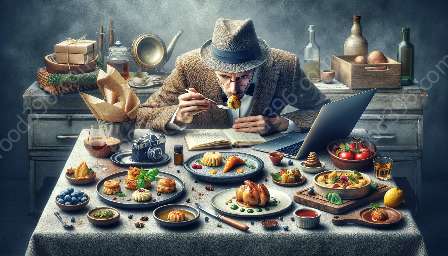Food styling is an art form that involves making food look visually appealing for photography, video, or presentation. In the culinary world, presentation plays a crucial role in attracting people to a dish. Whether it's a restaurant menu, a food blog, or a cookbook, the visual appeal of a dish can influence how it is perceived and enjoyed.
This guide explores the principles of food styling, providing valuable insights for creating stunning visuals that complement the art of food critique and writing. From understanding color and texture to mastering composition and lighting, this discussion delves into the intricate details of making food look as good as it tastes.
Understanding Color and Contrast
Color is a fundamental element of food styling. The use of vibrant and appetizing colors can make a dish more visually appealing. Understanding the color wheel and complementary colors can help create harmonious and eye-catching compositions. Contrasting colors can add visual interest to a dish, making it stand out and catch the viewer's attention.
Texture and Composition
Texture plays a significant role in the appeal of food. Crispy, crunchy, smooth, or gooey textures can evoke sensory experiences through visuals alone. Understanding how to balance and showcase various textures can elevate the visual appeal of a dish. Composition involves arranging elements within a frame to create a pleasing visual balance. The placement of ingredients, props, and negative space can impact the overall aesthetics of the image or presentation.
Effective Lighting and Angles
Lighting is a crucial aspect of food styling. Different types of lighting, such as natural light, artificial light, or a combination of both, can influence how food looks in a photograph or on a plate. Understanding how to manipulate light to create highlights and shadows can add depth and dimension to the presentation of a dish. Choosing the right angles to showcase the details and layers of a dish can also make a significant difference in the overall visual impact.
Bringing Style to Food Critique and Writing
Applying the principles of food styling can enhance the experience of food critique and writing. When food is presented in an appealing and appetizing manner, it can evoke emotions and anticipation, adding depth to the critique and narrative. Describing visual details, colors, textures, and the overall composition of the dish can enrich the writing and provide a more immersive experience for the reader.
Capturing the Essence in Photography
For food critique and writing that incorporates photography, understanding the principles of food styling is essential. The visual representation of a dish can complement the written content, allowing for a holistic and engaging experience for the audience. As a food writer or critic, being able to articulate the visual appeal of a dish adds depth and credibility to the critique.
Creating Visual Stories
Food styling can contribute to the creation of visual stories through food critique and writing. By understanding how to style and present food in a visually compelling manner, writers and critics can transport their readers into the world of culinary delights. The use of imagery and descriptive language can paint a vivid picture of the culinary experience, making the critique and writing more engaging and memorable.
Conclusion
The principles of food styling are integral to creating visually stunning dishes that are not only appetizing but also captivating to the eyes. By understanding the nuances of color, texture, composition, lighting, and angles, one can elevate the visual appeal of culinary creations. Applying these principles to food critique and writing can enrich the experience for both the creator and the audience, bringing the art of food to life through captivating visuals and engaging narratives.


